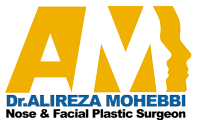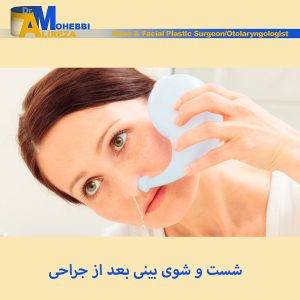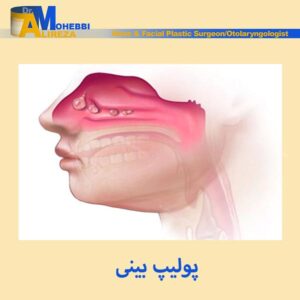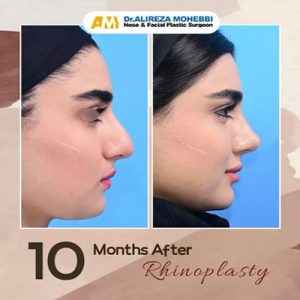- About rhinoplasty
- Getting advice about rhinoplasty
- Preparing for rhinoplasty
- The surgery
- Reduction rhinoplasty
- Augmentation rhinoplasty
- What to expect afterwards
- Recovering from rhinoplasty
About rhinoplasty
The shape and size of your nose is inherited from your parents. Your nose is generally fully developed by the time you’re 16.
An operation to have your nose reshaped can change the size and shape from the tip to the bridge of your nose including the nostrils. This is why it’s very important to be sure about what you don’t like about your nose and what you want changed.
You may decide to have it changed for cosmetic reasons or to restore the shape of your nose after an injury.
Getting advice about rhinoplasty
Make sure the surgeon you choose is a fully trained plastic surgeon . Before opting to have your nose reshaped, it’s vital that you discuss in full what you’re hoping to gain from the operation with your surgeon and the result you can realistically expect. It’s important to clearly explain what you think is wrong with your nose as well as any points you do like and explain how you want it to look after the operation.
Preparing for rhinoplasty
Your surgeon will explain how to prepare for your operation. For example, if you smoke you may be asked to stop, as smoking increases your risk of getting a chest and wound infection, which can slow your recovery.
Don’t have the operation if you have a cough, cold or sore throat because this can increase your risk of infection and bruising –. If you have any concerns, contact your surgeon for advice.
The operation is usually done under general anaesthesia. This means you will be asleep during the operation. Sometimes you may need to stay in hospital for a night or two.
You will be asked to follow fasting instructions. This means not eating or drinking, typically for about six hours before the operation. However, it’s important to follow your anaesthetist’s advice as some may allow sips of water up to two hours before the operation.
Your surgeon will discuss with you what will happen before, during and after your procedure, and any pain you might have. This is your opportunity to understand what will happen, and you can help yourself by preparing questions to ask about the risks, benefits and any alternatives to the procedure. This will help you to be properly informed, so you can give your consent for the procedure, which you will be asked to do by signing a consent form.
At your consultation, your surgeon will examine your nose and measure its shape and size. He or she will take photographs, either at your consultation or before the operation, so that the results of the surgery can be compared with your original appearance.
The surgery
The operation can take up to three hours depending on what needs to be done.
Reduction rhinoplasty
If you’re having your nose made smaller, your surgeon will usually make cuts inside your nostrils to reach the bone and cartilage. Sometimes, a cut is also made across the skin between your nostrils (the columella) and this technique is called ‘open rhinoplasty’. Some of the bone and cartilage will be removed or rearranged to achieve the shape you have agreed with your surgeon. The skin over your nose won’t be touched – it will shrink down to its new shape.
It may be necessary to also make your nostrils smaller to keep your features in proportion. Your surgeon will need to make cuts in the skin of your nostrils to do this. This will leave fine scars on each side.
Augmentation rhinoplasty
If you’re having your nose made larger or giving it more bulk, your surgeon may make a cut inside or between your nostrils and reshape the bone and cartilage. You may need extra bone or cartilage (a graft) to build up your nose. Your surgeon may take cartilage from your ears or ribs, and bone from the back of your elbow, your skull or your hip bone. Sometimes artificial implants, such as gortex or silastic, are used instead.
The cuts inside your nose are usually closed with dissolving stitches so they don’t need to be removed. If you have stitches in the outside skin, these will usually need to be removed. This is done about a week after your operation.
What to expect afterwards
You will need to rest until the effects of the anaesthetic have passed. You may need pain relief to help with any discomfort as the anaesthetic wears off.
You may have dressings (packs) in each nostril for a day or two. These will stop you from breathing through your nose. You may also have splints inside your nostrils as well as over your nose to keep the nasal bones in place for a week or two.
You will usually be able to go home when you feel ready.
You will need to arrange for someone to drive you home. Try to have a friend or relative stay with you for the first 24 hours.
Your nurse will give you some advice about caring for your nose when you go home. You will be given a date for a follow-up appointment.
Recovering from rhinoplasty
If you need pain relief, you can take over-the-counter painkillers such as paracetamol. Always read the patient information leaflet that comes with your medicine and if you have any questions, ask your pharmacist for advice.
General anaesthesia temporarily affects your co-ordination and reasoning skills, so you must not drive, drink alcohol, operate machinery or sign legal documents for 24 hours afterwards. If you’re in any doubt about driving, contact your motor insurer so that you’re aware of their recommendations, and always follow your anaesthetist’s and surgeon’s advice.
There are certain things you can do to help speed up your recovery.
- Keep your head up as much as possible. Sleep in a raised head position with extra pillows for at least the first two days after your operation or until the bruising has gone down.
- Keep the splints on your nose dry and don’t have a hot bath until the splint has been removed.
- Don’t blow your nose for at least the first week, only wipe it gently. If you need to sneeze, don’t try to block the sneeze.
- Don’t remove any crusts in your nostrils until you see your surgeon to have the splints removed.
- Stay away from dusty or smoky places until your nose has recovered.
- Don’t do any strenuous exercise or contact sports, such as rugby or football, for at least six weeks.
It’s likely that your nose will feel ‘bunged up’ for a few days after the operation so you will have to breathe through your mouth. This can make your lips dry, so use petroleum jelly or lip balm on your lips to stop them cracking.
Contact your surgeon if you:
- develop bleeding that doesn’t stop within 10 to 15 minutes
- develop an inability to drink or swallow normally
- have a high temperature
- get increasing pain
While there isn’t a medical reason why you should stay away from work, you will probably feel more comfortable taking two weeks off and returning when the bruising has gone down. It may take more than three weeks for the bruising to settle and the swelling may take longer to go down.
The time your dissolvable stitches will take to disappear depends on what type you have. However, for this procedure they should usually disappear in about seven to 10 days.
It will take several months before your nose settles into its new shape.
Postoperative Care Rhinoplasty
You have just had a “rhinoplasty” or surgery on your nose. There are incisions inside your nose, and in some instances a small incision in the tissue between your nostrils. All of your incisions, inside and outside, have been closed with dissolving sutures. The cartilage in your nose, and often the bones, have been carved apart, then reshaped and repositioned. You have delicate tape and possibly a molded plastic “splint” glued to the outside of your nose. The purpose of the tape and splint is to hold your cartilage and bone in their new position while they heal together, to minimize the swelling that you will have, and to protect your new nose.
This guide is written to provide you with instructions for the care of your new nose and to answer questions that you inevitably will have as your healing progresses. Please keep these instructions on hand for at least the next month as a reference source. And don’t hesitate to call our service (see below) if you have questions
that are not answered here in print.
Enjoy your new nose!!
I. Activities
For tonight and tomorrow night, please sleep on your back with your head elevated on two pillows.
Sleeping in a recliner chair is ideal. If you sleep on your side your nose will swell closed on the “down” side. Continuing to sleep on your back with your head slightly elevated for the next week is preferred.
Please keep ice packs across the plastic splint on your nose and both of your eyes until you go to sleep tonight and all day tomorrow. This is to prevent bruising of your eyes, minimize swelling of your nose and face, and to generally make you more comfortable.
Your nose will drain some mucus and a bit of blood for the first day or two after your surgery. This is perfectly normal. We will send you home with a drip pad of gauze under your nose to absorb this drainage. Please change the gauze as needed. We will clean out your nose at the first postoperative visit.
Don’t blow your nose for a week, but you may sniff backwards if needed.
You may walk as much as you like. For a week please do not run or do any aerobic exercises. Also, for the first week, do not lift anything over 10 pounds (including a child), do not bend forward with your head down, and do not strain in any way. For this first week, sexual activities should be very limited.
After a week, you may return to all your normal activities. You may wear your glasses lightly resting on your nasal cast or taped to your forehead .Please wear the lightest weight pair of glasses that you have. You may insert your contact lenses two days after surgery. After removal of your nasal splint at a week you should limit the time that you wear your glasses and continue to wear light-weight glasses.
You may expect some tenderness or discomfort on the sides of your nose after you’ve worn your glasses for a length of time. This is perfectly normal and may last for 3-4 months. When your nose becomes tender, remove your glasses for an hour or two.
Please do not drive for 24 hours after your surgery. Until that time, you will still be affected by the drugs you were given during your surgery, and it is not safe for you to drive. After a day you may drive limited amounts.
II. Diet
You may eat a normal diet after your surgery. You may find that swallowing solid foods is a bit difficult while your nose is stuffy.
Your sense of smell may be reduced for the first week but will soon return to even better than before. Please do drink lots of liquids to help your body recover from your anesthesia and your surgery.
III. Medications
You will be given pain medications to take only if you need them. Do not take them more often than instructed, and do not take them if you do not feel pain. These pills contain a mild narcotic and may make you light-headed or even nauseated. We would prefer that you take one or two over-the-counter 200-mg ibuprophen tablets every four to six hours if this controls your discomfort.
You will be given antibiotic pills to take. If you are given these, please take the medication as instructed, as it is important for proper healing. Take the antibiotics until they are completely gone.
You may be given cortisone (steroids) to take for a week. This is to help reduce swelling and discomfort.
Please take them exactly as the instructions are written.
Please resume taking all of your normal medications the day after surgery. It is wise to take a daily multivitamin pill during the month after surgery.
IV. Wound Care
You may sniff backwards through your nose at any time. But please don’t blow your nose for a week after your surgery. You will be asked to start using saline spray in your nose the day after surgery.
You should use two squirts in each nostril at least four times a day.
And you may use it as often as you like. The saline reverses the drying effect that the surgery has had on your nasal lining and should be used for at least the next three months. Do not use any other sprays in your nose unless you’ve been given specific instructions to do so by our office. Please do contact us if you have any questions in this regard.
If you do have a small incision in the tissue between your nostrils, we will give you an ointment to apply there. You should apply the ointment gently three times a day. We have used dissolving sutures to close your incision, but the sutures dissolve only if kept moist with ointment. Continue to apply the ointment three times a day until the sutures have wiped away – at about a week.
You may have had some cartilage borrowed from your ear to put into your nose. If so, the incision on your ear has been closed with the same dissolving sutures used in your nose. Apply the ointment to your ear sutures (these might be on the front or back of the ear) three times a day and continue to do so until all the sutures wipe away in about a week. You might also have a dressing on the front of your ear, and one on the back. If you have a dressing sewn to the ear, we will remove it on the day after surgery. Don’t try to remove or change these dressings.
The plastic mold or splint on the outside of your nose will be removed by us at about a week after surgery. You may wash your face and shampoo the day following surgery. It will not cause damage if your nasal splint dressing gets a bit wet, although we ask that you not run water directly onto the splint.
Similarly, you may wash around all of the incisions in your face the day after surgery. If they happen to get wet this will cause no problems.
V. Visits to Our Office
You might be asked to return to our office at the day after surgery. At this time, your nose will be gently cleaned out, and you will be started on nasal saline spray.
If you have a dressing on your ear, that will be removed during this first visit. If a one day post-operative appointment is not scheduled, please plan to return the following week. If questions or concerns arise in the meantime, do not hesitate to call.
One week after your surgery we will see you in our office. At this time, your outside nose splint will be removed and your nose will be gently cleaned out.
Your next visit will be at one month after your surgery.
Normally, we will then see you at 3, 6, and 12 months after the surgery. There is no charge for these visits. You may have postoperative pictures taken at these visits.
VI. Long-term Care
Swelling of your nose and the surrounding areas of your cheek and upper lip is the normal result of your nasal surgery. The swelling will gradually resolve over varying time periods. Swelling at the upper part of your nose between your eyes that is present when your plastic mold is removed should be gone by the end of the second week. The same is true for the minor swelling of your cheeks at the sides of your nose.
You may have some swelling in your upper lip (and even under your upper lip above your teeth) at the bottom of your nose. The mild tenderness and swelling here, too, will be gone within two weeks. There may well be minor swelling and a feeling of stiffness in the tip of your nose that persists well beyond the two-week period. In many cases, the tip may not be as delicate-appearing as we want it to be for up to six months after surgery. In some cases, we may inject a small amount of a form of cortisone into the tip to help in resolving this swelling.
Bruising around your nose in your cheeks and lower eyelids is very common after rhinoplasty surgery. It should be completely resolved by two weeks after surgery. If this bruising presents a problem in your return to work, we can provide you with some cover-up make-up.
Numbness over your nose is also quite normal following surgery. You will gradually regain sensation over the top of your nose. You can expect the tip to be slightly numb and “stiff” feeling for up to three months after surgery.
Breathing through your nose will gradually improve after we clean your nose out the day after surgery.
By a week after surgery your breathing should be much improved. It is vital in returning to normal breathing that you spray the inside of your nose frequently with saline spray.
You may be instructed in a set of Nasal Exercises. These exercises are intended to keep your nose narrowed and straight as the nasal bones heal back to the facial bones.
If you are instructed in using these exercises, please be diligent in using them for the first month after your surgery. In most cases they are not needed beyond that time.
You must protect your new nose from the sun for three months after surgery. Sun exposure will cause swelling in the nose and will slow down the healing process. The skin of your nose will actually be very likely to burn from sun exposure. Good protection for this three-month period means both a brimmed hat and a sun block of at least SPF 15.
VII. For any other questions that may arise, please do not hesitate to contact us at the numbers below:
Mobile: +989127200590
Tel:+982188677723-7
We would far rather answer your questions than to have you worry perhaps needlessly. And we very much hope that you enjoy your new nose in both function and appearance.





